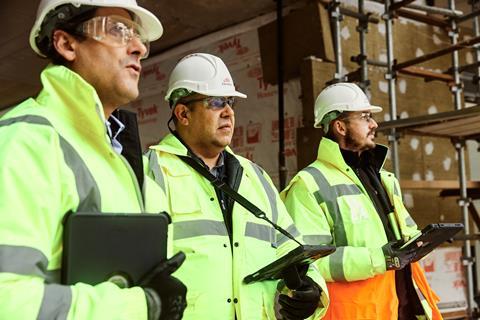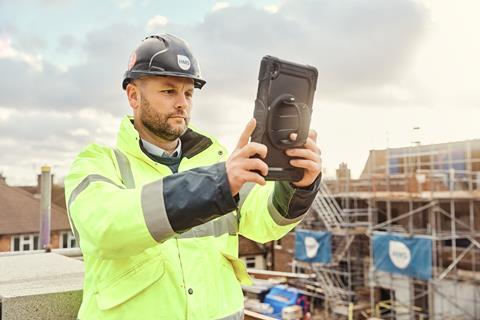Digital transformation is a journey many contractors have been embarking on and their investments are paying dividends, writes Brandon Oliveri-O’Connor, Procore’s head of region, EMEA

Digital transformation is a journey many contractors have been embarking on and their investments are paying dividends.
Using a construction platform to unlock and integrate data from across the business is providing fresh insights that are sharpening on-site and office operations – and boosting the bottom line.
As the year ahead looks like another tough one for construction – with sluggish growth and interest rates still high – contractors looking to protect margins in such a challenging operating environment need all the help they can get. Technology, and specifically construction platforms, can provide that help.
Unlocking data transforms operations
Approached correctly, the digitisation of construction’s many processes can make you far more efficient in the office and out on site. Data is your most important asset in advancing your digital transformation. When harnessed properly and shared appropriately its benefits stretch far beyond immediate operational efficiencies.

Why do I need more data, you may think - I already have loads. But that’s the point – you have lots of data, but likely it’s not being captured and channelled into an easily accessible place, you are not realising its full potential.
Construction platforms do exactly that for you. They unlock and bring together in one place data that’s vital to knowing what’s going on, at the project level or across the entire business. Think what that visibility could do for tracking your budgets and critical costs. We all know that the profitability of a contracting business is dependent on what happens on site.
Data helps you identify trends and point out where you need to focus your attention. This can transform project efficiency.
For example, RFI (requests for information), snags, inspections, variations and similar issues on a project can all be captured in one place through digital processes and viewed at the same time by every involved stakeholder.

That level of transparency allows everyone to see what is happening in real time – either at the project level or across a set of operations and helps build trust with clients and other stakeholders.
Risks on projects can be quickly detected and managed proactively, rather than having to be sorted out later down the line, with all the negative consequences that can have on timings and costs.
The data can be financial as well as project management data. Checking in any precise moment on how a project is tracking versus plan and budget is instantaneous. Think how valuable it would be to have ‘real time’ costings at your fingertips whenever you want them.
Operating an integrated project platform that can generate dynamic dashboards – showing either costs to date against budget or up-to-date timelines – allows financial decisions to be taken with greater confidence for all stakeholders.
It means that boards and senior managers gain greater control of their bottom line in a way that’s just not possible when data is siloed and unshared.

Data helps you manage risks more proactively
Managing risks more proactively helps improve productivity, not least by reducing considerably the amount of reworking required on site. Construction leaders in the UK and Ireland suggested digitisation could cut project costs by as much as 25% (Source: Procore’s 2023 ‘How We Build Now’ report).
Captured data also allows teams to compare and review performances on previous projects and see how to avoid any pitfalls previously encountered. So, for example, you can see if problems on projects seem to occur at a certain stage every time, providing the opportunity to try something different to buck the trend.
This level of forensic detail, and the continuous improvement that it drives, can help build a positive culture across projects and teams so they focus on delivering on time and budget, leading to better end results.
The more data you have the more you learn
Integrating data provides the opportunity to analyse, measure and report performance in all kinds of ways. For example, Procore offers out of the box analytics dashboards to get you started.
If your needs grow and you want the platform to facilitate a more bespoke approach to what and how you measure performance, this is also readily possible.
The beauty of analytics is that it gets better over time, as more and more data gets generated through frequent use. Meaning, even if you begin your data journey with an out of the box option, you are already building up better analytic capabilities further down the line.
And as the data becomes richer the more control you have over operations. Recurrent problems, and the stages they seem to occur at, can be addressed and rectified. Workloads can be managed better, and performances improved. A platform also cuts out hours of searching for data or completing basic admin tasks.
Integrated data benefits the entire business
Though not all platforms are made equal. As the industry continues to digitally transform, certain departments will inevitably continue using their own software. So your construction management platform needs to have a strong ecosystem of API connectors to integrate data around estimating, tendering, enterprise resource planning (ERP) and BIM. Let’s unpack this.
Having a single source of truth for project information helps in so many ways. Take tendering and estimating: using an integrated platform gives you all the information you need to become more accurate with your projected costings, which sharpens the tendering and estimating processes considerably and makes you more competitive.

The same applies with ERP. Planning, purchasing, inventory, sales and marketing – in fact, all the processes of a project or a business – can be integrated into one collaborative source of truth.
BIM too can be smoothly integrated into the platform so that changes in the design can be easily reflected in costs and programme. With platform technology like this at your fingertips, the latest information can be fast-tracked and informed data-driven decisions made and communicated across the team and to clients.
Essentially, it’s a better, more streamlined and seamless way of doing what you’ve traditionally done – and once on board, you’ll wonder why it’s taken so long to appreciate what a construction platform can do for your business.
Platforms help future proof the business
If construction platforms are to realise their full potential and transform business performance, they have to be easy to use. If they’re not, team members don’t input the data and ways of working don’t improve.
Your platform provider also needs to assist users with 24-hour support and professional services to ensure the software is being used to its full potential. Working with Procore, the global construction management software, managers and their teams can rely on all the back-up they’ll ever need.
That’s a massive plus when dealing with on-site challenges or pan-business decisions. Having an accurate state of play at your fingertips helps you plan and prepare better for the unexpected. Because skills and labour shortages are a constant in this industry, as can be supply chain hitches or extreme weather events.
Equipping your teams with the right technology allows them to work as efficiently as possible. Leveraging data and powerful analytics doesn’t only help you now: it makes you more resilient to weather those financial storms, and equip your teams and the business for the future.


























